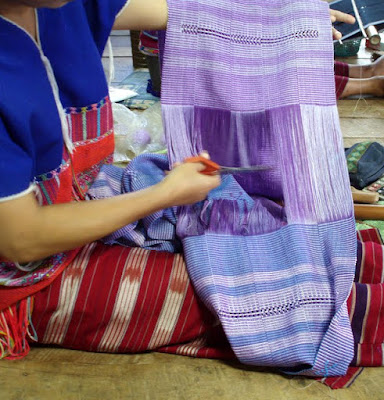Doi Inthanon is part of a mountain range located in northern Thailand, at the border between Thailand and Burma (Myanmar). Only an hour or so from Chiang Mai, it is the tallest mountain in Thailand (2565 meters) and is part of a national park. The summit is usually enshrouded in mist, but supposedly on a clear day you can see the whole valley including the city of Chiang Mai.
We did an all-day excursion to the park. Inside the park we visited two waterfalls, the impressive Wachirathan waterfall...
...and the smaller Sirithan waterfall.
The walk through the rainforest was great. It was drizzling slightly, and the temperature was about 20 degrees cooler than in Bangkok. We were actually cold at times, which felt nice.
Very near the summit are the Naphamethanidon
chedi.
Twin
stupas were erected by the Royal Thai Air Force to commemorate King Bhumibol's 60th birthday in 1987, and Queen Sirikit's 60th in 1992.
They are Buddhist places of worship. The King's stupa (called Phra Mahathat Chedi Naphamethanidon) is a copper color.
The outside of this stupa is decorated with bas-reliefs and copper-colored mosaic tiles.
The interior has a yellow and blue motif (the colors of Thailand's royalty -- the king's flag is yellow, blue for the queen) and a large seated Buddha figure. The history of the Buddha's life is inscribed on the walls in Thai and in English.
In contrast is the Queen's stupa, called Phra Mahathat Chedi Naphabolbhumisiri. It is lilac in color and it's exterior is decorated with purple mosaic tiles and delicate tile frescoes portraying Buddhist themes.
Inside is a standing Buddha and the colorful mosaic ceiling tiles depict the Buddha's teachings.
Beside the Queen's stupa is a lush garden. All the grounds are beautifully manicured.
There were also a few whimsical touches here and there, like these playful elephants and the heart-shaped flower beds.
After visiting the national park, we stopped at a Karen hill tribe village nearby. The Karen people live in small farming communities. Their houses are built on stilts and some use the traditional roofing material of teak leaves, which need to be replaced every few years. Corrugated tin is a modern alternative.
Rice is one of the primary crops grown by the Karen tribe. They are generally environmental conscious and practice crop rotation to minimize the need for clearing new swaths of forest (unlike some farmers who use slash-and-burn techniques). Here, rice grows in terraced fields.
There are several divisions within the Karen tribe, the villagers we visited are known as White Karen. Unlike other subdivisions of the
Karen tribe, the women in this tribe do not wear the neck rings that unnaturally elongate the neck. They are called White Karen because the unmarried women of the tribe wear white woven tunics until they are married.
The women are skilled weavers, using back-strap looms to create colorful fabrics. This woman is weaving two scarves on the same loom.
She finished just a few minutes later. It takes about four days to complete each pair of scarves. A single scarf sells for 250 baht (about $8.33). When the scarves are sold, each one bears a sticker with the weaver's name on it. The weaver earns 200 baht per scarf, the remaining 50 baht goes into a collective pool to buy weaving supplies for all the women to use.
This blanket was made by five women. Each one wove a panel which was then stitched together to make the blanket.
We were so pleased that we were able to visit the national park area while we were in Chiang Mai. It was a truly memorable experience. When we got back to the hotel, a surprise was waiting for Kevin from the hotel staff. It was certainly a birthday to remember!





















No comments:
Post a Comment